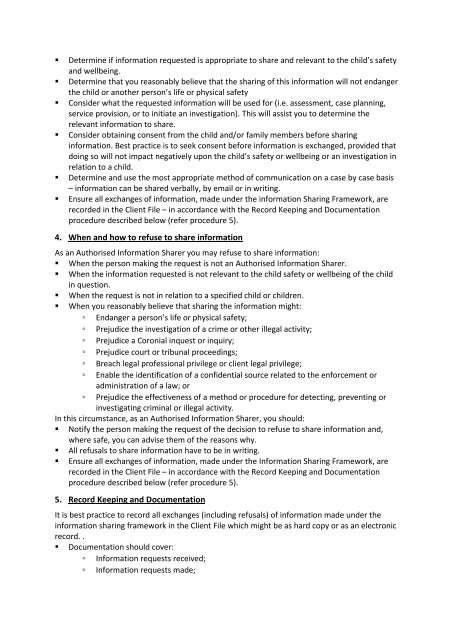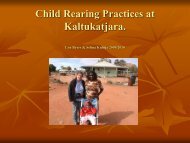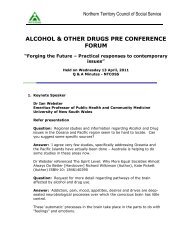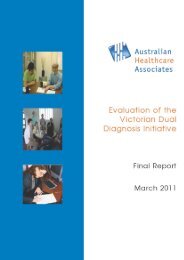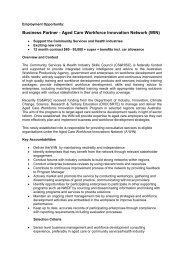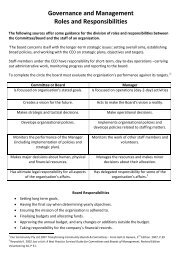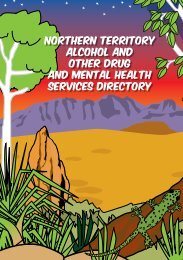1.0 Information Sharing Policy - Northern Territory Council of Social ...
1.0 Information Sharing Policy - Northern Territory Council of Social ...
1.0 Information Sharing Policy - Northern Territory Council of Social ...
You also want an ePaper? Increase the reach of your titles
YUMPU automatically turns print PDFs into web optimized ePapers that Google loves.
• Determine if information requested is appropriate to share and relevant to the child’s safety<br />
and wellbeing.<br />
• Determine that you reasonably believe that the sharing <strong>of</strong> this information will not endanger<br />
the child or another person’s life or physical safety<br />
• Consider what the requested information will be used for (i.e. assessment, case planning,<br />
service provision, or to initiate an investigation). This will assist you to determine the<br />
relevant information to share.<br />
• Consider obtaining consent from the child and/or family members before sharing<br />
information. Best practice is to seek consent before information is exchanged, provided that<br />
doing so will not impact negatively upon the child’s safety or wellbeing or an investigation in<br />
relation to a child.<br />
• Determine and use the most appropriate method <strong>of</strong> communication on a case by case basis<br />
– information can be shared verbally, by email or in writing.<br />
• Ensure all exchanges <strong>of</strong> information, made under the information <strong>Sharing</strong> Framework, are<br />
recorded in the Client File – in accordance with the Record Keeping and Documentation<br />
procedure described below (refer procedure 5).<br />
4. When and how to refuse to share information<br />
As an Authorised <strong>Information</strong> Sharer you may refuse to share information:<br />
• When the person making the request is not an Authorised <strong>Information</strong> Sharer.<br />
• When the information requested is not relevant to the child safety or wellbeing <strong>of</strong> the child<br />
in question.<br />
• When the request is not in relation to a specified child or children.<br />
• When you reasonably believe that sharing the information might:<br />
◦ Endanger a person’s life or physical safety;<br />
◦ Prejudice the investigation <strong>of</strong> a crime or other illegal activity;<br />
◦ Prejudice a Coronial inquest or inquiry;<br />
◦ Prejudice court or tribunal proceedings;<br />
◦ Breach legal pr<strong>of</strong>essional privilege or client legal privilege;<br />
◦ Enable the identification <strong>of</strong> a confidential source related to the enforcement or<br />
administration <strong>of</strong> a law; or<br />
◦ Prejudice the effectiveness <strong>of</strong> a method or procedure for detecting, preventing or<br />
investigating criminal or illegal activity.<br />
In this circumstance, as an Authorised <strong>Information</strong> Sharer, you should:<br />
• Notify the person making the request <strong>of</strong> the decision to refuse to share information and,<br />
where safe, you can advise them <strong>of</strong> the reasons why.<br />
• All refusals to share information have to be in writing.<br />
• Ensure all exchanges <strong>of</strong> information, made under the <strong>Information</strong> <strong>Sharing</strong> Framework, are<br />
recorded in the Client File – in accordance with the Record Keeping and Documentation<br />
procedure described below (refer procedure 5).<br />
5. Record Keeping and Documentation<br />
It is best practice to record all exchanges (including refusals) <strong>of</strong> information made under the<br />
information sharing framework in the Client File which might be as hard copy or as an electronic<br />
record. .<br />
• Documentation should cover:<br />
◦ <strong>Information</strong> requests received;<br />
◦ <strong>Information</strong> requests made;


